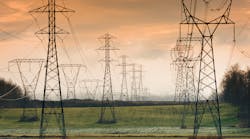It seems like every other week a new company or city announces another aspirational renewable energy goal. California and Hawaii have 100% renewable or zero-emission energy sources for electricity mandates in the future. More than 150 large companies have pledged to go “100% renewable electricity” and cities are adopting Climate Action Plan.
What’s missing from these goals is a detailed plan to upgrade the grid to be able to handle increasingly large amounts of intermittent and distributed energy resources.
For most, if not all, of these organizations, going aggressively in renewable means purchasing enough renewable energy to match the amount of electricity they use annually.
All that wind and solar power adds up, and its intermittency isn’t something our more-than-100-year-old electrical grid technology is able to handle with ease. Most of the nation’s grids were designed to deliver electricity one way, from large central power plants that are always on to population centers that consume the power. There was no plan to include small generators, like rooftop solar panels and fuel cells, on the grid — because they weren’t invented or cost-effective yet.
As referenced by Gretchen Bakke in her book The Grid, and subsequent NPR interview, one in eight homes in Hawaii is equipped with solar panels, which together produce more energy than is needed on sunny days. However, the Hawaii grid is unable to use or even store the majority of that energy. While the future of batteries can help, that technology alone won’t solve the problem. What’s needed is a smarter, faster operating system for the grid, designed specifically to manage renewable and distributed energy resources.
A flexible, modern system (and the lack thereof)
Conventional grid-control technology was designed to handle steady or high-inertia generation from fossil-fuel power plants. A renewable power facility using inverters that do not have a spinning mass is in effect dealing with low-inertia generation, which requires a much faster and more real-time control to dynamically manage the flow of electrons onto the grid.
On top of 1990s-era technology that is still being used throughout the grid, many grid-control systems are running SCADA functions that provide a snapshot of the system to inform the human operator every few seconds. Fortunately, new technology is now available that can do everything the old SCADA systems do, and much more.
A modern makeover for an out-of-style grid
The grid needed for today’s modern energy generation is one that is smarter, operates autonomously and in real time. It’s one that is networked to allow a two-way flow of electricity and real-time communication, as well as machine learning and AI that provide self adjustment, contingency planning and remote operation.
Overhauling how we generate our energy from fossil fuel resources to renewable ones is only the first step. Now that solar and wind have matured, it’s time to tackle the underlying challenges of renewable integration presented by our existing one-way transmission and distribution delivery systems — the lines that deliver electricity to homes and businesses, and that increasingly are being used to carry power back onto the grid from rooftop solar panels on homes and other buildings.
Modernizing our electrical grids means leveraging existing technology on the system, and marrying it with new and more intelligent software platforms that can utilize that technology in new ways. By taking advantage of existing synchrophasor sensors within the grid system to deliver real-time grid data of the changes in renewable energy generation, and using AI to make lightning fast and more accurate decisions to deploy a dynamic mix of energy resources, we have the opportunity to maximize the benefits of all energy resources at very high levels of renewables on the grid.
Such technology has already been deployed at the Auwahii wind and battery storage project in Maui, Hawaii. The project proved software, insightful synchrophasor data and AI could result in an electrical grid with smoother power output and faster frequency regulation, and ensure a maximum number of renewable generators stay connected to the grid by keeping frequency fluctuations under control.
Such software technology is also active at a winery in California’s Napa Valley. The software is a part of a larger microgrid project that features over 600 kW of solar power and 420 kWh of battery storage. The on-site generation system can seamlessly connect to and disconnect from the utility grid, and provide voltage controls at the property to protect sensitive equipment, such as refrigerators and pump systems, while saving money and energy during peaks times.
By intelligently deciding how to meet the requirements of the grid and how we can quickly and accurately operate our electric grid to provide real-time control of resources, we can greatly increase our use of renewable power, without giving up any of the reliability, power quality or control that we’re accustomed to. In other words, the industry must recognize this century-old method of using slow centralized generators as the primary tool to balance the grid will not work well with the fast-changing distributed renewable resources being adopted in all parts of the grid. To succeed, we must adopt this new grid-control capability that takes advantage of speed and precision, and multi-tasking of inverter-powered resources as the primary grid-balancing tool while complementing it with the slow but powerful spinning-generation resources to maximize the value of each unique energy resource. Without such a shift in the grid operations mindset, we are ignoring foundational weaknesses in our utility grid and holding the world back from realizing the true promise of renewable energy.


